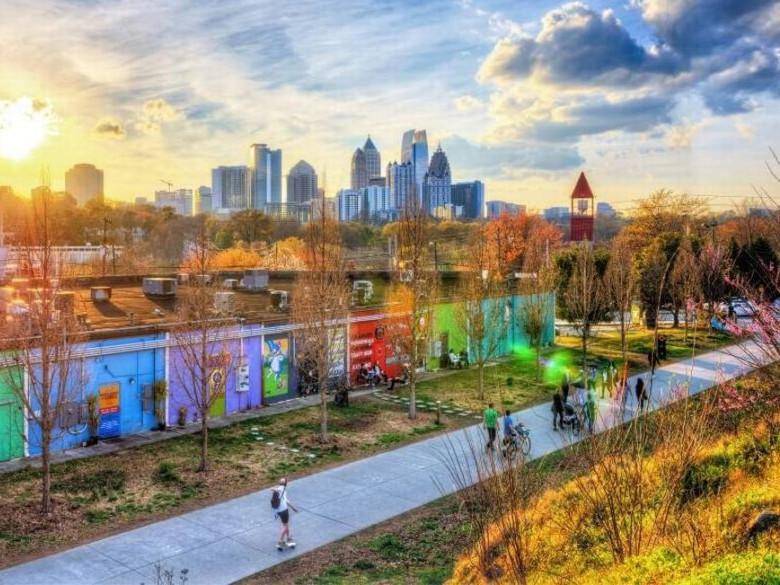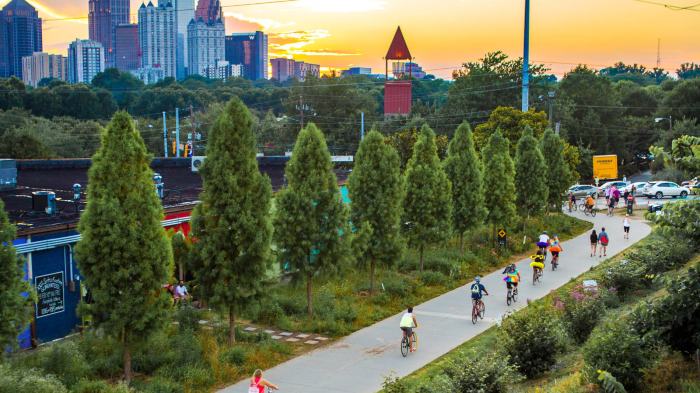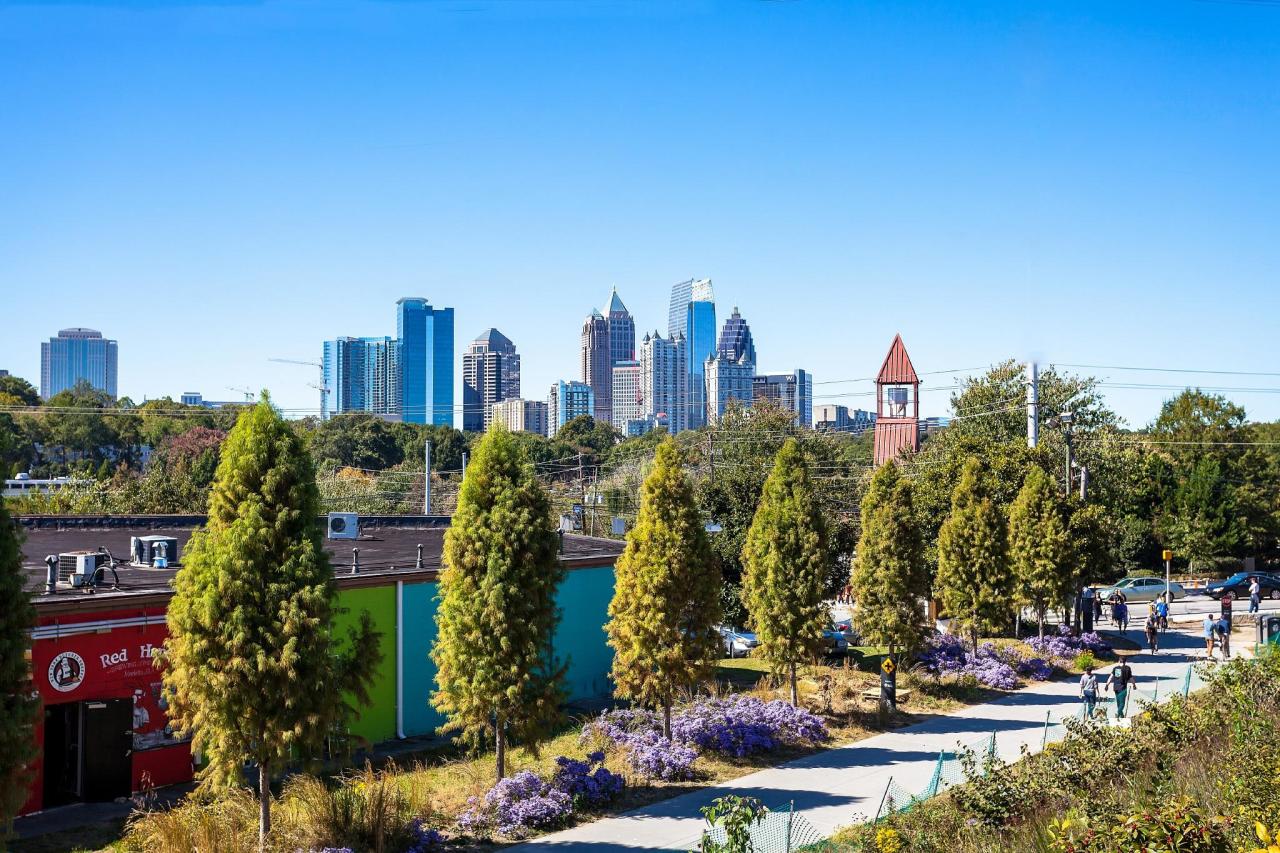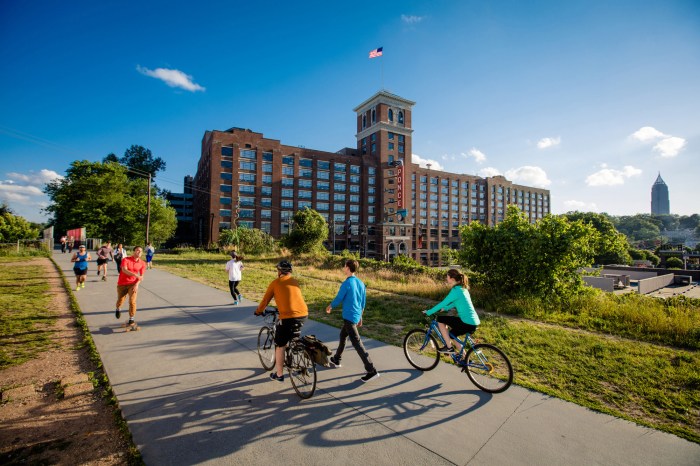The Atlanta BeltLine, an ambitious urban renewal project, has transformed Atlanta’s landscape, creating a vibrant tapestry of public spaces, transportation options, and economic opportunities. As we delve into the multifaceted story of the BeltLine, we uncover its history, impact, and vision for the future.
From its inception as a visionary concept to its current status as a beloved urban amenity, the BeltLine has shaped Atlanta’s identity, fostering a sense of community and inclusivity while promoting sustainability and environmental stewardship.
Atlanta BeltLine Overview

The Atlanta BeltLine is a 22-mile loop of multi-use trails, parks, and transit that is being built on a former railroad corridor around the city of Atlanta, Georgia. The BeltLine was conceived in the early 1990s as a way to revitalize Atlanta’s inner-city neighborhoods and to create a more sustainable and livable city. The project is being built in phases, with the first phase, the Eastside Trail, opening in 2008. The BeltLine is expected to be completed by 2030.
The BeltLine is more than just a trail. It is a catalyst for economic development and neighborhood revitalization. The project has already spurred the creation of new businesses, parks, and affordable housing along its route. The BeltLine is also a place for people to walk, bike, run, and socialize. It is a place for people to connect with their community and with nature.
Exploring Atlanta’s BeltLine, a vibrant trail system encircling the city, is a fantastic way to experience its diverse neighborhoods and parks. However, before embarking on your journey, consider using a travel budget calculator to estimate expenses like accommodation, transportation, and food.
With this tool, you can plan a budget-friendly trip while still enjoying the BeltLine’s many attractions.
Route
The Atlanta BeltLine is a 22-mile loop that encircles the city of Atlanta. The route follows the former Atlanta & West Point Railroad corridor, which was abandoned in the 1960s. The BeltLine is divided into four quadrants: the Northeast Trail, the Southeast Trail, the Southwest Trail, and the Northwest Trail. The Northeast Trail is the most complete section of the BeltLine, with 10 miles of trails open. The Southeast Trail is under construction, with 3 miles of trails open. The Southwest Trail is in the planning stages, and the Northwest Trail is still in the early stages of development.
Phases
The Atlanta BeltLine is being built in phases. The first phase, the Eastside Trail, opened in 2008. The second phase, the Westside Trail, is under construction and is expected to open in 2023. The third phase, the Southside Trail, is in the planning stages and is expected to open in 2025. The fourth and final phase, the Northside Trail, is still in the early stages of development.
Current Status
The Atlanta BeltLine is a major project that is still under construction. However, the project has already had a significant impact on the city of Atlanta. The BeltLine has helped to revitalize inner-city neighborhoods, create new businesses, and provide a place for people to walk, bike, run, and socialize. The BeltLine is a major asset to the city of Atlanta and is expected to continue to have a positive impact on the city for years to come.
Economic Impact
The Atlanta BeltLine has had a significant economic impact on the surrounding neighborhoods. The project has spurred the development of new businesses and residences, increased property values, and generated tax revenue.
Businesses and Developments
The BeltLine has attracted a variety of businesses, including restaurants, shops, and breweries. These businesses have created jobs and contributed to the revitalization of the area. The project has also spurred the development of new housing, including apartments, condos, and single-family homes. This has increased the population of the area and boosted the local economy.
Property Values and Tax Revenue, Atlanta beltline
The BeltLine has had a positive impact on property values in the surrounding neighborhoods. A study by Georgia State University found that property values within a half-mile of the BeltLine increased by an average of 10% since the project began. This has led to increased tax revenue for the city of Atlanta.
Transportation and Connectivity

The Atlanta BeltLine plays a pivotal role in enhancing transportation options and connectivity within the city. It serves as a multimodal transportation corridor that seamlessly integrates various modes of transportation, fostering accessibility and mobility for residents and visitors alike.
The BeltLine connects diverse neighborhoods and destinations, creating a more interconnected urban fabric. It provides a vital link between the city’s core and its surrounding communities, bridging gaps and promoting a sense of cohesion. By facilitating seamless movement between different areas, the BeltLine empowers residents with greater freedom and convenience in accessing employment, education, recreational opportunities, and essential services.
Modes of Transportation
The BeltLine offers a comprehensive range of transportation options, catering to the diverse needs of commuters. These include:
– Walking and Running: The BeltLine features dedicated trails specifically designed for pedestrians and joggers, providing a safe and enjoyable environment for exercise and recreation.
– Biking: Cyclists can take advantage of the BeltLine’s extensive network of bike lanes and paths, making it a convenient and eco-friendly way to navigate the city.
– Public Transportation: The BeltLine integrates seamlessly with Atlanta’s public transportation system, with several MARTA (Metropolitan Atlanta Rapid Transit Authority) stations located along its route. This enables commuters to easily transfer between the BeltLine and other public transportation modes, such as buses and trains.
– Electric Scooters and Bikes: The BeltLine allows for the use of electric scooters and bikes, providing an additional option for short-distance travel and last-mile connectivity.
– Future Rail Transit: Plans are underway to incorporate light rail or streetcar service along the BeltLine, further enhancing its role as a multimodal transportation corridor.
Public Spaces and Recreation
The Atlanta BeltLine is a transformative project that has created a network of public spaces and recreational opportunities for Atlanta residents and visitors alike. The BeltLine’s public spaces are designed to be inclusive and accessible, offering a variety of amenities and activities for people of all ages and abilities.
The BeltLine’s public spaces include parks, trails, playgrounds, and greenways. The parks are designed to be inviting and relaxing, with features such as picnic areas, benches, and water fountains. The trails are perfect for walking, running, or biking, and they offer stunning views of the city. The playgrounds are designed to be fun and safe for children, and they include a variety of play equipment. The greenways are designed to connect different parts of the city, and they offer a peaceful and scenic way to explore Atlanta.
The Atlanta BeltLine, a 22-mile loop of trails and parks, offers a unique way to explore the city. Whether you’re looking for a leisurely stroll or a challenging hike, the BeltLine has something for everyone. And if you’re looking for a place to relax and take in the views, be sure to check out the 230 fifth rooftop bar.
With its stunning views of the city skyline, it’s the perfect place to unwind after a day of exploring the BeltLine.
Amenities and Activities
The Atlanta BeltLine offers a wide variety of amenities and activities for visitors to enjoy. These include:
- Picnic areas
- Benches
- Water fountains
- Trails
- Playgrounds
- Greenways
- Art installations
- Fitness stations
- Dog parks
- Community gardens
Impact on Green Space and Livability
The Atlanta BeltLine has had a significant impact on the city’s overall green space and livability. The project has created over 2,200 acres of new parkland, and it has connected many of the city’s neighborhoods to each other. The BeltLine has also made Atlanta a more walkable and bikeable city, and it has helped to improve air quality.
If you’re a fan of the Atlanta BeltLine, you’ll love Alicante, Spain. This coastal city has a beautiful waterfront promenade that’s perfect for walking, running, or biking. And just like the Atlanta BeltLine, the Alicante promenade is lined with restaurants, shops, and cafes.
The Atlanta BeltLine is a vital part of the city’s infrastructure, and it has had a positive impact on the lives of Atlanta residents. The project has created new public spaces, recreational opportunities, and green space, and it has helped to make Atlanta a more livable city.
Community Engagement and Inclusivity: Atlanta Beltline
The Atlanta BeltLine has been planned and developed with extensive community involvement, fostering a sense of ownership and inclusivity among residents. Community engagement efforts have included public meetings, workshops, and online platforms to gather feedback and input from diverse stakeholders.
The BeltLine has fostered a sense of community and inclusivity by connecting neighborhoods, creating shared spaces, and providing opportunities for physical activity and social interaction. The BeltLine has become a destination for residents and visitors alike, promoting community pride and a sense of place.
Community Events and Programs
The BeltLine hosts a variety of community events and programs that promote inclusivity and engagement. These include:
- Community walks and bike rides: Encouraging physical activity and exploration of the BeltLine.
- Farmers markets: Supporting local farmers and providing access to fresh produce in underserved communities.
- Art installations and performances: Showcasing local artists and creating a vibrant cultural atmosphere.
- Community gardens: Promoting urban agriculture and fostering a sense of community.
- Educational programs: Offering workshops and classes on topics related to health, wellness, and sustainability.
Sustainability and Environmental Impact
The Atlanta BeltLine is a model of sustainability and environmental stewardship, showcasing innovative measures to reduce its ecological footprint while enhancing the natural environment.
From its inception, the project has prioritized environmental protection and restoration. The BeltLine’s design incorporates green infrastructure, such as bioswales, rain gardens, and permeable pavements, to manage stormwater runoff and reduce pollution. These features help filter pollutants, recharge groundwater, and prevent flooding.
Air Quality Improvement
- The BeltLine’s extensive tree canopy and green spaces absorb carbon dioxide and release oxygen, contributing to cleaner air.
- The project promotes walking, cycling, and public transportation, reducing vehicle emissions and improving air quality.
Water Quality Improvement
- The BeltLine’s green infrastructure systems capture and filter stormwater, preventing pollutants from entering waterways.
- The project has restored riparian buffers along streams, reducing erosion and improving water quality.
Habitat Restoration and Biodiversity
- The BeltLine has created new habitats for native plants and animals, increasing biodiversity and ecological resilience.
- The project’s greenways and parks provide corridors for wildlife movement and support urban ecosystems.
Energy Efficiency and Renewable Energy
- The BeltLine’s buildings and infrastructure are designed to be energy-efficient, reducing greenhouse gas emissions.
- The project incorporates solar panels and other renewable energy sources to generate clean electricity.
Challenges and Future Plans

The development of the Atlanta BeltLine has faced several challenges, including:
- Funding: The project’s massive scale and long timeline have required significant funding, which has been a challenge to secure consistently.
- Community displacement: Concerns have been raised about the potential for the BeltLine to displace low-income residents and businesses, particularly in historically marginalized communities.
- Environmental impact: The construction and operation of the BeltLine have the potential to impact local ecosystems and air quality.
- Political and bureaucratic hurdles: The BeltLine’s development has involved coordination between multiple government agencies and stakeholders, which can lead to delays and complications.
Ongoing Efforts and Future Plans
Despite these challenges, the Atlanta BeltLine project is ongoing and making progress. The BeltLine Partnership, a non-profit organization, is working to secure funding and address community concerns. The organization is also committed to minimizing the project’s environmental impact and ensuring that the BeltLine benefits all Atlanta residents.
The vision for the BeltLine’s future is to create a vibrant, connected, and sustainable city. The BeltLine will provide a network of trails and parks that will improve transportation options, enhance public spaces, and promote economic development. The project is expected to have a significant impact on Atlanta, making it a more livable, equitable, and resilient city.
Last Word

As the Atlanta BeltLine continues to evolve, it stands as a testament to the power of collaboration, innovation, and community engagement. Its legacy as a transformative urban trail will undoubtedly inspire future generations, shaping Atlanta’s growth and livability for years to come.
Frequently Asked Questions
What is the total length of the Atlanta BeltLine?
The Atlanta BeltLine will span approximately 22 miles upon completion.
How does the BeltLine promote sustainability?
The BeltLine incorporates green infrastructure, such as bioswales and rain gardens, to manage stormwater runoff and improve water quality. It also encourages alternative modes of transportation, reducing air pollution.
What are some of the challenges faced during the development of the BeltLine?
The project has faced challenges related to funding, land acquisition, and coordination among multiple stakeholders.